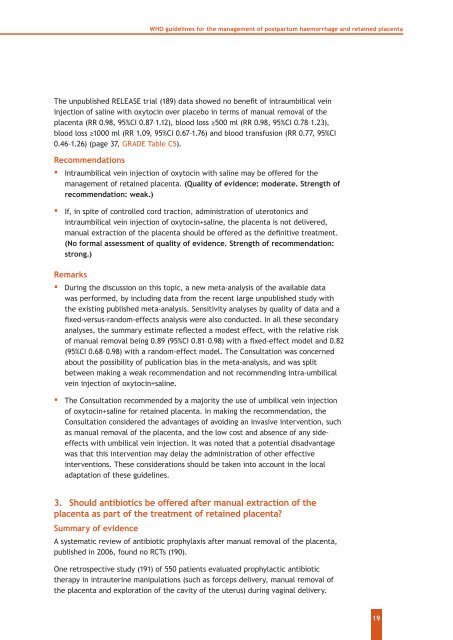WHO guidelines for the management of postpartum haemorrhage ...
WHO guidelines for the management of postpartum haemorrhage ...
WHO guidelines for the management of postpartum haemorrhage ...
Create successful ePaper yourself
Turn your PDF publications into a flip-book with our unique Google optimized e-Paper software.
<strong>WHO</strong> <strong>guidelines</strong> <strong>for</strong> <strong>the</strong> <strong>management</strong> <strong>of</strong> <strong>postpartum</strong> <strong>haemorrhage</strong> and retained placenta<br />
The unpublished RELEASE trial (189) data showed no benefit <strong>of</strong> intraumbilical vein<br />
injection <strong>of</strong> saline with oxytocin over placebo in terms <strong>of</strong> manual removal <strong>of</strong> <strong>the</strong><br />
placenta (RR 0.98, 95%CI 0.87–1.12), blood loss ≥500 ml (RR 0.98, 95%CI 0.78–1.23),<br />
blood loss ≥1000 ml (RR 1.09, 95%CI 0.67–1.76) and blood transfusion (RR 0.77, 95%CI<br />
0.46–1.26) (page 37, GRADE Table C5).<br />
Recommendations<br />
▪ Intraumbilical vein injection <strong>of</strong> oxytocin with saline may be <strong>of</strong>fered <strong>for</strong> <strong>the</strong><br />
<strong>management</strong> <strong>of</strong> retained placenta. (Quality <strong>of</strong> evidence: moderate. Strength <strong>of</strong><br />
recommendation: weak.)<br />
▪ If, in spite <strong>of</strong> controlled cord traction, administration <strong>of</strong> uterotonics and<br />
intraumbilical vein injection <strong>of</strong> oxytocin+saline, <strong>the</strong> placenta is not delivered,<br />
manual extraction <strong>of</strong> <strong>the</strong> placenta should be <strong>of</strong>fered as <strong>the</strong> definitive treatment.<br />
(No <strong>for</strong>mal assessment <strong>of</strong> quality <strong>of</strong> evidence. Strength <strong>of</strong> recommendation:<br />
strong.)<br />
Remarks<br />
▪ During <strong>the</strong> discussion on this topic, a new meta-analysis <strong>of</strong> <strong>the</strong> available data<br />
was per<strong>for</strong>med, by including data from <strong>the</strong> recent large unpublished study with<br />
<strong>the</strong> existing published meta-analysis. Sensitivity analyses by quality <strong>of</strong> data and a<br />
fixed-versus-random-effects analysis were also conducted. In all <strong>the</strong>se secondary<br />
analyses, <strong>the</strong> summary estimate reflected a modest effect, with <strong>the</strong> relative risk<br />
<strong>of</strong> manual removal being 0.89 (95%CI 0.81–0.98) with a fixed-effect model and 0.82<br />
(95%CI 0.68–0.98) with a random-effect model. The Consultation was concerned<br />
about <strong>the</strong> possibility <strong>of</strong> publication bias in <strong>the</strong> meta-analysis, and was split<br />
between making a weak recommendation and not recommending intra-umbilical<br />
vein injection <strong>of</strong> oxytocin+saline.<br />
▪ The Consultation recommended by a majority <strong>the</strong> use <strong>of</strong> umbilical vein injection<br />
<strong>of</strong> oxytocin+saline <strong>for</strong> retained placenta. In making <strong>the</strong> recommendation, <strong>the</strong><br />
Consultation considered <strong>the</strong> advantages <strong>of</strong> avoiding an invasive intervention, such<br />
as manual removal <strong>of</strong> <strong>the</strong> placenta, and <strong>the</strong> low cost and absence <strong>of</strong> any sideeffects<br />
with umbilical vein injection. It was noted that a potential disadvantage<br />
was that this intervention may delay <strong>the</strong> administration <strong>of</strong> o<strong>the</strong>r effective<br />
interventions. These considerations should be taken into account in <strong>the</strong> local<br />
adaptation <strong>of</strong> <strong>the</strong>se <strong>guidelines</strong>.<br />
3. Should antibiotics be <strong>of</strong>fered after manual extraction <strong>of</strong> <strong>the</strong><br />
placenta as part <strong>of</strong> <strong>the</strong> treatment <strong>of</strong> retained placenta?<br />
Summary <strong>of</strong> evidence<br />
A systematic review <strong>of</strong> antibiotic prophylaxis after manual removal <strong>of</strong> <strong>the</strong> placenta,<br />
published in 2006, found no RCTs (190).<br />
One retrospective study (191) <strong>of</strong> 550 patients evaluated prophylactic antibiotic<br />
<strong>the</strong>rapy in intrauterine manipulations (such as <strong>for</strong>ceps delivery, manual removal <strong>of</strong><br />
<strong>the</strong> placenta and exploration <strong>of</strong> <strong>the</strong> cavity <strong>of</strong> <strong>the</strong> uterus) during vaginal delivery.<br />
19
















